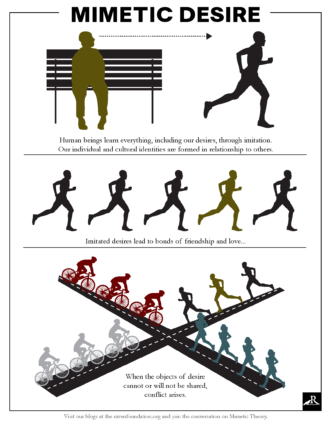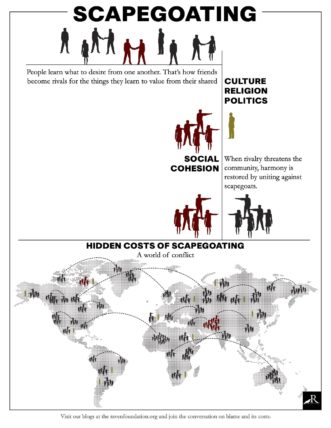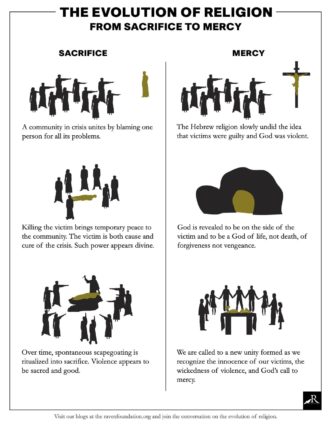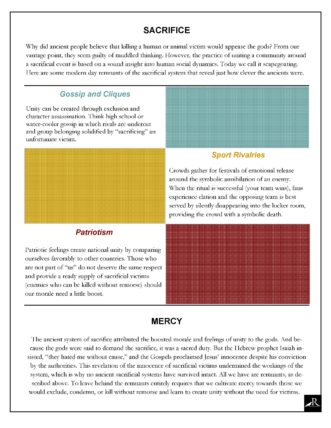



Mimetic Theory FAQs
Q. Why is mimetic theory important?
A. Mimetic theory is important because it allows us to think clearly and honestly about the greatest threat to human survival: our own violence. It offers the best available analysis of the causes of conflict, the contagion of violence, and the pervasive use of scapegoating by individuals and communities. But its enduring value is found in the guidance it offers for how to end the plague of violence and establish a real and lasting peace.
Q. What is mimetic theory?
A. Mimetic theory explains the role of violence in human culture using imitation as a starting point. “Mimetic” is the Greek word for imitation and René Girard, the man who proposed the theory over 50 years ago, chose to use it because he wanted to suggest something more than exact duplication. This is because our mimeticism is a complex phenomenon. Human imitation is not static but leads to escalation and is the starting point for innovation. Girard’s great insight was that imitation is the source of rivalry and conflict that threatens to destroy communities from within. Because we learn everything through imitation, including what to desire, our shared desires can lead us into conflict. As we compete to possess the object we all want, conflict can lead to violence if the object cannot be shared, or more likely, if we refuse to share it with our rivals.
Girard believes that early in human evolution, we learned to control internal conflict by projecting our violence outside the community onto a scapegoat. It was so effective that we have continued to use scapegoating to control violence ever since. The successful use of a scapegoat depends on the community’s belief that they have found the cause and cure of their troubles in this “enemy”. Once the enemy is destroyed or expelled, a community does experience a sense of relief and calm is restored. But the calm is temporary since the scapegoat was not really the cause or the cure of the conflict that led to his expulsion. When imitation leads once again to internal conflict which inevitably escalates into violence, human communities will find another scapegoat and repeat the process all over again.
By reading ancient myths Girard realized that ancient sacrificial religions originated in a community’s attempt to ritualize the scapegoating cure. Prohibitions forbade the mimetic envy and rivalry that lead to conflict; ritual sacrifices recreated the expulsion or death of the scapegoat. By reading the Bible, Girard realized that the Judeo-Christian tradition reveals the innocence of the scapegoat and so renders ancient religion ineffective. The last 2,000 years is witness to humanity’s attempt to find non-sacrificial ways to control our rivalry and conflict. Christian apocalyptic literature predicts our failure to do so. Finding ways to form unity and ease conflict without the use of scapegoats is thus the key to establishing a real and lasting peace.
Mimetic Desire
Q. What does Girard mean by “desire”? Does it refer to sexual desire?
A. When we hear the word “desire” we often think of sexual desire, but in mimetic theory there is more to it than that. It’s helpful to know the difference between needs and desires. Needs are instinctual, while desires are learned through mimesis (imitation). Sex, for example, is a biological need but it is by imitating the desires of others that we find ourselves directed toward a certain sexual partner. This is why two friends may end up desiring the same lover – they are mimetically sharing their desire. What is important from Girard’s perspective is that for human beings, the object of desire is not fixed.
For example, when cows (non-human) are hungry (a biological need) they eat grass. They don’t have to decide what to eat, the object of their need for food is fixed and unchangeable – it’s grass and it will always be grass. For humans, when we feel hungry we have a big decision to make! We must choose the object that will satisfy our desire for food and the object can change day to day, hour to hour, depending on whose desire is influencing ours at that moment. In fact, sometimes we eat for a completely different reason than to satisfy our hunger. Cows don’t do that!
Girard’s work is founded on the often hidden reality that human desire is aimless. It wants without knowing what it’s objective is. This is why for Girard, our desire is always related to another person, book, advertiser, teacher, movie – something to give our desire direction. He says it quite simply: we desire according to the desire of another.
Q. Is mimetic desire a good thing or a bad thing?
A. Mimetic desire is a human thing. The difference between humans and our nearest primate ancestors is not that monkeys imitate and we do not, but that we are better at it than they are! Human beings are spectacularly good imitators and it was the explosion of our mimetic abilities that triggered our evolutionary development. Humans have tools, agriculture, language, memory, technology, science, religion, literature, drama, visual arts – all the elements of culture because we are the best imitators around. We are not bound to a narrow set of instinctual behaviors. Instead we are free to explore the world around us, to learn from experience, to benefit from shared knowledge that can be passed from generation to generation. Without the ability to imitate, there would be no human culture and no humankind as we know it. That sounds like a good thing!
Q. How does mimetic desire lead to conflict?
A. Because all desire is mimetic it is also triangular. Contrary to popular belief, objects do not have intrinsic value nor do our desires arise spontaneously within us. Our desire is unattached to any particular object and so it depends upon a model who can direct it toward an object. In other words, there is never a straight line between us and the object of our desire – our desires are copied from models or mediators whose objects of desire become our objects of desire. But the model or mediator we imitate can become our rival if we desire the same object he is imagined to have. Or other imitators of the same model may compete with us for the same objects. The more these models turned rivals desire the object, the more my desire is increased. Jealousy and envy are inevitably aroused in this mimetic situation.
Another important cause of conflict is pride. Because we enjoy believing in our independence, even the independence of our desires, we deny that our rival is also our model. He seems to be only a willful enemy determined to block the fulfillment of my desire out of wickedness and so my hatred and envy seem to be completely justified. Rather than acknowledge how much alike we are at the level of desire (the foundation for friendship), we instead nurse resentment that flatters our false sense of superiority.
Q. Do I choose my models or is it an unconscious process?
A. Models of desire are all around us and can be real people in our lives, imaginary characters from novels or movies, or influences from our culture like music, tastes in foods, clothing styles, values and religious or political beliefs. Sometimes we are open about our models as when we acknowledge someone as a teacher, mentor or inspiration. But often our models are unknown or unacknowledged. We may be unaware of or deny their influence over us or we may perceive them to be rivals or enemies. Or a mentor may become a rival when our mutual admiration turns to rivalry over a coveted prize we have both learned to desire intensely from one another. Oddly, rivalry with a model both conceals and intensifies their role as our model. Girard calls this mimetic rivalry because it is a conflict which originates in shared or imitated desire.
Mimetic Desire Infographic
Click on the image to see an enlargement.
Download the infographic.
Scapegoating
Q. What is scapegoating?
A. Scapegoating is an unusual phenomenon because we recognize it when we see it in others, but never in ourselves. Other people’s scapegoats appear to be innocent victims, falsely accused of wrongdoing, and that is indeed what they are. But our own scapegoats appear to us as guilty evildoers who deserve our hatred and the punishment we righteously mete out against them. We always see the innocence of other people’s scapegoats but never our own. That is why we are all always at risk of harming an innocent person or group without ever realizing it.
Q. How does a community benefit from scapegoating?
A. Scapegoating is the age-old way of finding relief from the internal conflict caused by mimetic rivalry. A scapegoat is blamed for the group’s disorder and when they are expelled or killed, peace returns. Here’s how it works: While the community is consumed with conflict, there are many small quarrels and conflicts, many accusations flying around. But when one person makes an accusation that is repeated and imitated, spreading like a contagion through the entire community, soon all are united behind the same accusation, against the same scapegoat. In this sense, Girard says that the scapegoat is arbitrarily chosen – why is this accusation imitated and not that one? Because it doesn’t matter, really. Any scapegoat will do because the goal is not to actually solve the problems that triggered the conflict, but to allow the group to discharge its resentment and hostility safely, in a way that unifies the community instead of destroying it.
Once there is unanimity against the scapegoat, the community forgets their own moral shortcomings and frustrations with each other. They now share a common cause—eliminate the one they now believe has caused all this trouble—which creates unity and social cohesion, for everyone except the scapegoat! Girard calls this “unanimity minus one” and is the shorthand formula for scapegoating. By the way, the ancient Hebrews were so suspicious of unanimity minus one, that if someone was accused of a crime and the verdict was unanimous, the accused was set free!
Q. What are the characteristics of a scapegoat?
A. The importance of the scapegoat is that it ends conflict due to mimetic rivalry by uniting others against it. For conflicted persons or groups to unite against a scapegoat, they must be able to identify personally to some extent with the scapegoat, but they must not identify so much that they rise to his defense. The scapegoat has certain traits that isolate him or her at the margins of society. He must have no family, friends or social connections who will argue on his behalf or seek to avenge his death. In this way, victimizing the scapegoat does not lead to social reprisals, which would escalate the conflict. History reveals the tendency of a majority in society to scapegoat a marginalized minority because of cultural, gender, physical and/or religious differences.
On the other hand, the scapegoat does not necessarily have to be weak. The main point is that the scapegoat is isolated with few defenders. Often a frenzied crowd can turn against powerful members of a society, such as a king, military general or president who can easily be blamed for all of society’s ills. A rebellion or coup then takes place.
Even more interesting, a scapegoat can actually be guilty of a crime and still function as a scapegoat. Scapegoating is not a question of innocence or guilt according to the law. If a community is establishing unity, discharging resentment, or concealing the true origins of their conflict by uniting against someone or some group, then it is a case of scapegoating whether or not the scapegoat is actually guilty of breaking the law. Because a scapegoat is a scapegoat by virtue of being innocent of the charge that they are the cause of the community’s problems. Guilty of a crime yet innocent of the community’s problems – that’s a real possibility when it comes to scapegoating.
Q. How does scapegoating work at the individual level?
A. Scapegoating functions individually at the level of identity. Too often our identity, and in particular our sense of our own goodness, is dependent on being over against someone or something else. We often establish our goodness against someone else’s wickedness and if we are doing that, then it is a case of scapegoating. Why? Because we need the other to be wicked to know we are good and whether or not they are actually wicked is beside the point. We are using others to solidify our identity the same way a community uses a scapegoat to solve its internal conflict. We see this in political, religious, national and cultural identity formation. Some Republicans demonize Democrats to know they are good and vice versa. Some Muslims demonize Christians and vice versa. In cases of scapegoating, we do not listen to one another because we don’t want to see our scapegoat’s suffering or hints of his goodness. These things might weaken our accusation against him and then our sense of goodness will break down.
Scapegoating Infographic
Click on the image to see an enlargement.
Download the infographic.
Religion
Q. What role did scapegoating play in ancient sacrificial religions?
A. Girard hypothesizes that the spontaneous phenomenon of scapegoating occurred over and over in early proto-human groups and was eventually ritualized into ancient sacrificial practices. This use of ritualized scapegoating to control conflict and establish unity is what made culture possible. Often it is believed that ancient religions arose out of mistaken or delusional thinking and were unnecessary add-ons to human evolution. Girard believes the opposite: ancient sacrificial religions were incredibly reasonable and realistic and absolutely essential to human development. Without peace and unity, no community can accomplish anything; they disintegrate before they can innovate. And peace and unity is exactly what the ancient sacrificial practices provided.
Scapegoating is also the origin of the apparently contradictory nature of the ancient gods who often represent both good and evil qualities in one divinity. This makes sense once you realize that after the elimination of the scapegoat (ritualized into sacrifice), the scapegoat is miraculously discovered to be a divinity who restores order and peace. The gods thus represent the principle of order and disorder, a principle that controls outbreaks of violence within the community by executing a small does of violence against an isolated victim or victim group.
Q. What is myth?
A. Modern scholars tend to think that myths are completely imaginary, fabricated stories that arose out of the primitive mind of early man. Often it is thought that myths came first and then rituals and sacrificial practices evolved out of these stories. For Girard, it is always the reality of spontaneous scapegoating violence which comes first. This violence brings peace to a conflicted community and over time rituals which repeat the violence against the scapegoat in a controlled form emerge as preventive measures against the return of the violence. Myths are the stories told by the community to justify its use of ritual violence against the victim.
The purpose of myth is to conceal the truth of the innocence of the sacrificial victim, because in order for the sacrifice to be effective the community must believe in the guilt of the victim (just as it did when the scapegoating occurred spontaneously), Therefore, myth places blame solely on the victim, siding with the community, or crowd. Myth further justifies itself by demonizing the victim as the sole source of the contagious violence and disorder within the community. Thus for Girard myth is at best only half the story: the community does indeed experience a sense of relief and restoration of peace when the victim is sacrificed. But myth also conceals the deeper truth that the victim was arbitrarily chosen, innocent of the community’s problems, and wrongly executed.
Q. Is Christianity an example of a myth?
A. Christianity is often critiqued as simply an example of another ancient myth that involves a dying and rising god. For Girard, however, it is Christianity which destroys the power of myth to conceal the innocence of the victim. In the Christian narrative, the victim of the crowd’s violence is innocent, falsely accused by both religious and secular authorities, and put to death in the most shameful of circumstances. There is no duality within Christ as there is with the gods of myths: Jesus is not portrayed as the cause of the community’s problems, but always portrayed as innocent despite the accusations against him. Girard has famously said that the secret heart of the sacred is violence itself. He has also said that the Christian gospel reveals is that the secret heart of God is non-violent, self-giving unto death. Quite a contrast!
Evolution of Religion Infographic
Click on the image to see an enlargement.
Download the infograph.
Solving the Problem of Violence
Q. What if the biggest threat we face is our own violence?
A. These days there is no shortage of global problems that seem to threaten the very existence of our species. Ecological disaster, terrorism, failed states, wars, refugees, and faltering economies all pose serious threats. Yet, according to mimetic theory, the biggest threat to any community does not come from an outside enemy, but from escalating violence due to mimetic rivalry within the community itself.
This is due to our mimetic natures. Mimetic desire inevitably leads to conflict which can escalate into what Hobbes called a war of all against all. While external enemies may from time to time threaten a community, the community would not exist at all if it could not solve the problem of its own violence. Most importantly, in order to come together to solve the problems of global warming, violent enemies, the devastation caused by war and the economic impact of globalization we must find a way to overcome out resentments and internal conflicts. Unless we can work together, we will succumb to threats and problems that could have been overcome.
Q. Isn’t violence good when it defeats our enemy?
A. The most common belief about violence is that if it is used by good people for a good cause against an evil enemy then it is not only good, it is necessary and noble.
Unfortunately, this reasoning is flawed and self-serving. All people who use violence do so believing in their own goodness, in the justice of their cause, and in the wickedness of their enemy. The ability to condemn the violence of our enemies while justifying the same action when we do it, is a product of the scapegoating phenomenon. When violence threatens a community, whether from within or without (what we assume is bad violence), expelling or killing an innocent victim restores unity and peace (what we assume is good violence). Because scapegoating produces this temporary calm, the belief in good violence has been part of human culture since its foundation.
However, the violence is only good from the point of view of the survivors, those who benefited from the violence. If you could ask the dead or exiled scapegoat for his opinion, he would proclaim his innocence and condemn the violence of the community. But his voice has been silenced and so there is no one left within the community to question the goodness of the violence. When internal discord and conflict returns, which it inevitably does, violence will once again be used as the solution.
Q. How can we create a more peaceful world?
Violence remains a problem for humanity because good people continue to use violence to achieve peace. Such a peace will always be partial because it creates victims and the peace is only temporary because it postpones rather than solves the community’s problems. To end the threat of violence, good people must condemn it not only when it is used against them, but when they use it against others.






